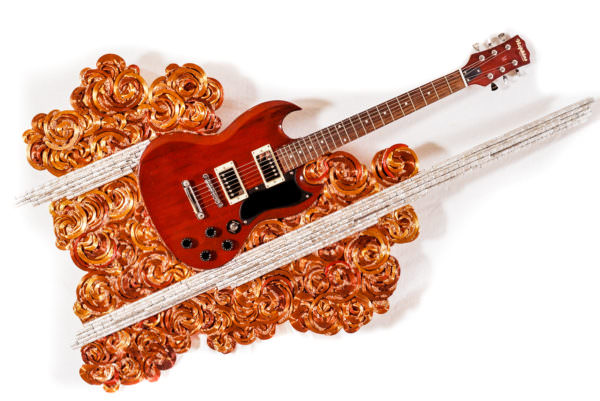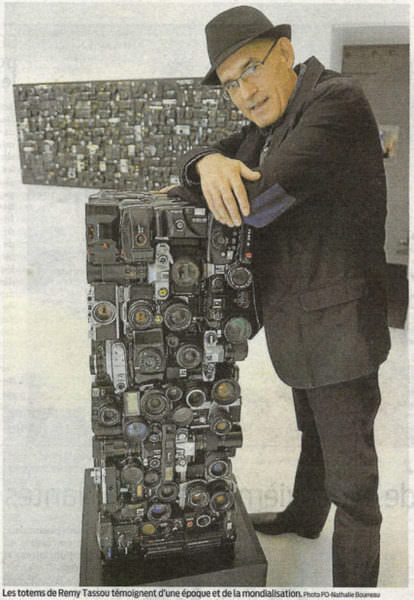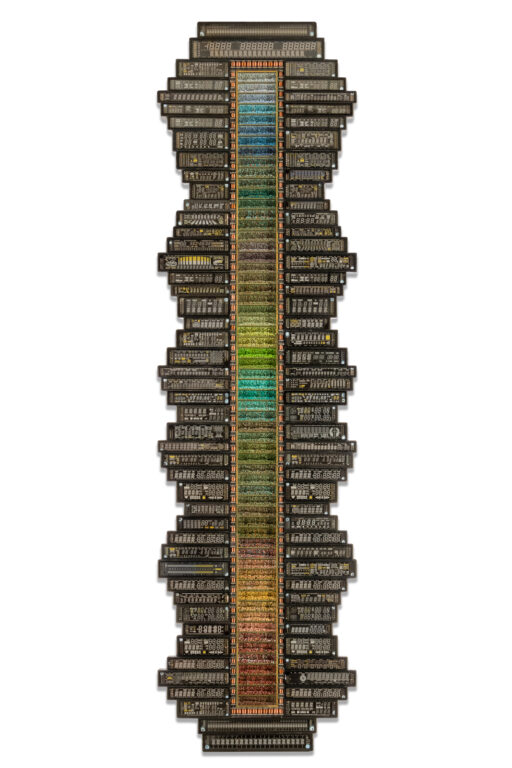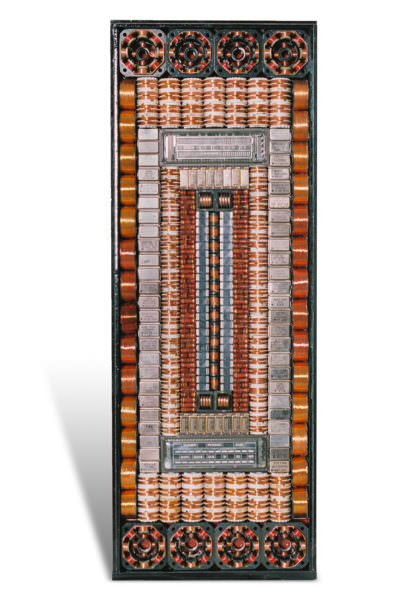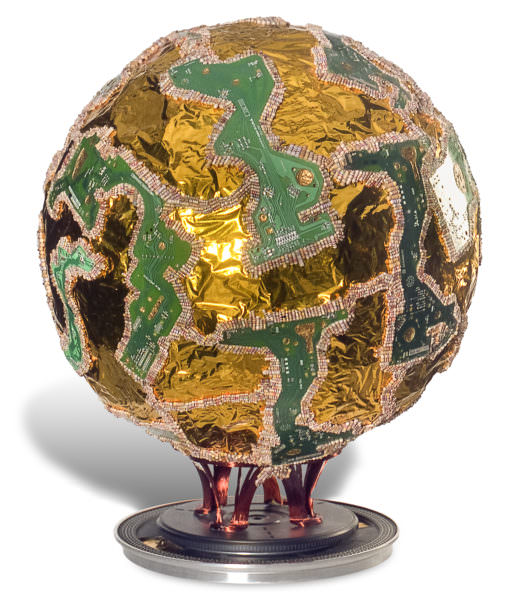Here are the main interviews
2015. Anne-Claire Roussy
2013. Eric Cabanas
2012. Chloé Chamouton
2008. Peggy Mintun
2005. Stéphane Vapillon
Anne-Claire Roussy – Professor at Paul Bert School – Antony (92). 2015, june
How to value electronic waste? An artistic response: Mr. Tassou’s sculpture
We observed and studied in detail the six works of M. Tassou which are exposed to the school until the end of June.
First, we observed from afar, from close up, very closely, looking from the front, from the side, on the top … the exhibited works by expressing our first impressions. Then we asked about what we saw, the components we thought we recognized, trying to imagine where it came from and what the final work represented or meant.
Then, we were on the websites of M.Tassou to find the works that we had on exhibition at the school, to take the dimensions, to seek additional information on how they were made, with what materials, to understand that it was the artist’s approach or what path he had to better understand how one becomes an artist.
We found several works that looked alike with small differences in materials or workmanship. We had to be very observant to distinguish those we had at school. Others were more unique, easier to distinguish.
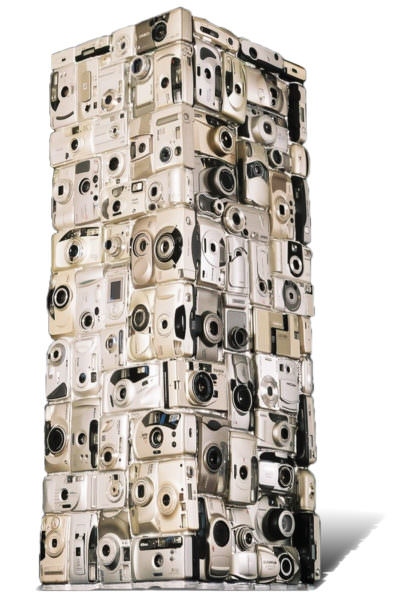
“Espio”
Espio: We counted 158 cameras used. Is there any inside the sculpture? We counted several devices called Espio on the work.
The sculpture is hollow. There are no appliances inside. Only pieces of wood are used to consolidate the structure so that the totem does not deform.
I try not to put the same camera twice in a totem. If there are several devices that bear the name Espio, it is likely that they are not completely identical.
Espio: How did you do to not have holes between the cameras? We have seen the small silver cement between the devices but how did you do so that they are all very intertwined with each other?
The “small silver cement” is made of neoprene gel glue which after drying is painted silver color. This glue is available in supermarkets. When buying one must be careful not to take liquid neoprene glue much harder to use.
Regarding the assembly of devices this is where my expertise and my experience lies. For the devices to be well nested to each other, simply position the right device in the right place. It’s the same thing in painting. To be a good painter just use a brush to deposit the right amount of paint in the right place … This is also called the job …
Great Balls of Fire: Does the guitar still work if you plug it? Where does this guitar come from? Who was she?
The guitar works theoretically because in fact I have never tried. It’s an electric guitar that needs to be connected to a power amplifier and I do not have an amp because I’m not a musician. For my hobbies I prefer chess and French billiards, the one where you play with three balls. This guitar was made in China and I bought new especially to make this sculpture.
To make a work, do you have the necessary materials or idea first?
For me there are two kinds of sculptures. Those that are ordered by customers, orders and those that I do freely, creations. For the orders, it is a question of remaking a coin because people only order pieces that they have already seen. It is then necessary that I make sure to have the available materials before accepting the order. In this case, I first check the necessary materials. For creations, I can do whatever I want from the available stock. In this case I am interested in the idea first.
Do you have a pretty good idea of what you want to create when you start making a work?
I have a very specific idea. Before starting a play I take some notes. I know exactly its height, its width, its thickness and I can evaluate the weight. If I close my eyes I can visualize it in outline but there are areas of shadow. During manufacturing, I often take a different path from the one I envisioned. Faced with technical and aesthetic problems I often let myself lead to another type of finish than originally planned.
Do you make a plan or drawing of what you imagine before you start manufacturing?
To build a house, an architect draws plans that he gives to the builder to do the work. When I work I am both architect and mason. So I do not need plans but I still note some ribs.
How long do you need to make a new work?
My time is divided equally between two activities. Recover the electronic components and make the works. Recovering components means finding machines (TVs, computers, VCRs, players …), disassembling them, recovering the components that must then be cleaned and sorted. I dismount about 300 machines each year. Making a work takes a few weeks. It takes two for Espio or Sunny, three for Le Cloud, five or six for Winbond or Motorola, three or four for Great Balls of Fire. It is not very precise because the time I do not count it. By cons I take it.
Do you have an assistant (several?) Who helps you to collect, disassemble, sort the objects or components to make your works?
I work alone and in silence. I am every day at the workshop around 9 am and I work until 18h. I do not take holidays or holidays because I’m bored. But actually working is not the right word. The artists do not work. They play as musicians or actors do. All the artists play. I play cutting pliers and tube glue … Workers need a vacation but not those who spend their time playing.
What tools do you use most frequently to create a work?
I have a lot of tools of all kinds. Mainly pliers and tools for cutting or grinding. There is an indispensable tool that I use every day for the manufacture of parts. It’s the caliper. It allows to take internal or external dimensions working at the tenth of a millimeter.
How is your workshop? We imagine it vast and cluttered with multiple electronic objects half disassembled with lockers and boxes everywhere to sort and store components and works in progress … (Do you have a photo?)
By separate email I made you a photo report on the workshop. I live in a big white house with garden. My studio occupies the entire ground floor. In the garden I have a small garage and a small storage room. I sort the components into jars and wooden crates that I put inside. For objects that I have in larger quantities I store outside in black plastic waterproof boxes. Everything is stored precisely. There is a place for everything and everything is in its place. When I get a machine I immediately dismount it and immediately distribute the components. There are no half-disassembled objects, no components lying around and no machines waiting to be dismantled. By cons there are often several parts in manufacturing simultaneously.
How many did you do in all? We did not manage to count on your site.
I keep an illustrated register of photos with all the pieces I made from the beginning. “Mosaic” the last piece bears the number 822. On the site tassou.com there is a little less, exactly 615, because I do not show the “repetitions” that is to say the pieces that are alike .
What is your favorite work? Which one do you like the least?
My favorite piece is the “Olympus” camera totem. I am often ordered this piece that sells around the world and I have every time a great pleasure to make it. I’m glad they go away. This year I have shipped to Kuwait and Singapore. As for those that do not please me they are very varied. There are those that do not look like what I had imagined, those that have defects of construction, those that are too heavy or too high or too wide … There is always a defect but I finish all the same all parts and I show almost everything.
Do you prefer to do abstract or figurative works?
I do very little figurative. There is the Cyberfly, the butterfly that you can see on The Cloud and the Cybervarius, a copper violin that I made in several copies. I much prefer abstract works.
What do you feel when you turn waste thrown into admired works?
I feel like an alchemist who knows how to make gold with waste. I have the magic formula …
Do you get to live from selling your works pretty well? Or do you have another activity to be sure of eating?
I am not very well known but I manage to live by selling my works. I have two types of clients. On the one hand electronics manufacturers who buy parts to decorate the hall of their factory or make gifts to their good customers and on the other hand collectors who are interested in the heritage side of the works I make. For them, these sculptures that reflect the design and technology of our time are called to take value and this that is the notoriety that I happen to have in my lifetime. I have no other activity than sculpture and I earn about the same as a teacher. For me to be better known, that my works are selling better it would be necessary that the newspapers televisions and internet talk more often about me. Many journalists are in Paris. By exhibiting in your school near the capital I can hope to meet one.
How many works do you sell on average per month?
There are different types of works, especially small and large ones. There are months where I only sell small as in December with Christmas presents. There are months where I sell only one big piece and others where I do not sell anything. It is very irregular and it is thus by year and turnover that it is necessary to count. I sell a dozen pieces a year.
Are you copied? Has anyone ever taken your idea of a work?
Salvator Dali said that the copy was “the proof of art”. Unfortunately for now I have not been copied. But there are other artists who have made works with electronic components. What sets me apart is probably having used exclusively electronics for twenty years. It must also be said that copying one of my works is not so simple. You have to have the equipment and the know-how. There are many more copies and fake in painting because to copy a painting is very easy. It is enough for a good painter to have a paint brush and a painting.
Were you a good student at school? Good student in visual arts?
I was not in the best but I never redoubled. I was good at math. As for the plastic arts, that did not exist when I was at school. From time to time, on Wednesday afternoons when it was raining, we were painting. I was not good at all. On the other hand, at home, I made canvas with cotton thread and a needle, as well as bindings. I tinkered a lot with my father.
What are the biggest difficulties to face to become a known and recognized artist?
Picasso said that the most difficult for an artist is the first thirty years … An artistic approach is very long and you must know before starting. The main problem is the lack of money. Today out of 100 artists there are only five who manage to live from their work. In general the first years we sell nothing and it is expensive in tools and materials. After a few years sales begin to cover these costs and it is only after ten or fifteen years that one becomes financially independent. Personally I am a sculptor for twenty years and I worked part-time in an insurance company during the first ten years. And like everyone else, we must also face doubt and discouragement. Most artists become famous after their death. This sometimes gives pause.
What do you think is the most important quality to succeed as an artist in our time?
First a good physical condition. The first quality is good health and vitality. You have to be toned and well rested to be active and creative every day. It takes good intellectual agility because to create it is not enough to find an answer to a question. We must find all the answers to then make the right choice. You have to practice your art every day and aim for excellence all the time. You must not drink wine.
Then you have to be in the creation. To create is to do something that does not exist. If you do traditional painting you rub 5,000 years of art history and tens of thousands of painters. Difficult then to be original. If you’re doing graphic design on the computer you’re rubbing shoulders with 50 years of digital creation history. It is already a lot. By cons if you make sculptures with a 3D printer you rub to 5 years of creation. It’s much easier … An artist is always a child of his time. Creating with the tools of his time seems to me the most important quality to succeed as an artist in our time.
Finally you have to follow his path without worrying about difficulties. When a piece is finished you have to do another one a little better. Art does not sell. He buys himself. By doing better and better, there comes a moment when the desire for acquisition manifests itself and where the first customers arrive. We must always continue and never give up because everything is possible for those who work. And this is the most important because as Matisse said: “Even for the greatest genius, nothing is possible without hard work.”
Eric Cabanas – Journalist at Presse Océan – November 5, 2013
SCULPTURE. The Nantes artist Rémy Tassou exhibits until November 9 in Nantes at Loïc Vallée.
The “antiquities of the future”.
The works of the Nantais sculptor Rémy Tassou, a real work of memory, leave in the whole wave.
Ocean Press: Why did you choose electronic waste as a material?
Rémy Tassou: “All my work revolves around WEEE, waste electrical and electronic equipment.Electronic really does not appear until after 1945. It’s a new material that previous generations could not imagine and that brutally invades society, its place is enormous in our daily life, in all areas.It is important to make a work of memory.For the electronics of tomorrow will be invisible, stuck between the constant progress of the miniaturization and the arrival in force nanotechnology Today, on the circumference of a hair we put three thousand transistors.These are new capsules, new forms.On the latest smartphones there is no resistance.It is the same with the hard drives or RAMs, a memory duty is required”.
“It is said that an artist is a child of his time, the time is in electronics, telephony, digital This totem reflects the design and technology of our time but also a specific date in history This is the technological breakthrough that corresponds to the digital switchover, a heritage piece that corresponds to a specific date.
devices are in working order but people do not use them anymore. “
You talk about antiquities of the future?
“Last year when Karl Lagerfeld did the scenography for the 26th Biennale des Antiquaires at the Grand Palais, he acquired one of my camera totems, posing next to a poster, saying it was this is the antiquity of the future.This totem was exhibited on the Cartier stand “.
Do you always think of having material?
“Yes, it is evolving, the electronics, from the eighties and then the nineties, is very beautiful, as is the case today, the materials are changing, the industrialists are obliged to re-encapsulate, The amazing thing is that the components come from all over the world, from Mexico, Portugal, Singapore, all of which was assembled in China and shipped back to Europe. the same way, the transistor used in a computer in Nantes is the same as that of a computer used in Japan, it’s fascinating. “
Chloé Chamouton – Journalist at Nantes Reportages – December 2012.
Rémy Tassou:
“An aesthetic work and an act of memory”.
In his workshop in Saint-Herblain, in the heart of the family home, Rémy Tassou creates and shapes original works from electronic components, giving birth to poetic and aesthetic compositions. Creations that the artist considers as heritage and perennial, defying time. Through these sculptures close to science fiction, Rémy Tassou gives himself as an ambition to act of memory. Interview with a visionary who has to his credit more than 500 pieces exported and sold around the world.
What is your art?
My philosophy feeds on electronics. This is a particular material, composed of various small elements (diodes, capacitors) which appears in the forties. Over the years and decades, electronics has undergone a process of miniaturization, accentuated by nanotechnologies. The components have become invisible It is the gradual disappearance of this exceptional material that motivated me to create For 20 years. I realize at the same time an aesthetic work, which amuses me, and a work of memory of this technology, by assembling works composed of these electronic elements. These become heritage because they are dated and correspond to a given period of the technical revolution.
Do you work with recovery materials? Where do you provide?
Envie 44, in Nantes, is responsible for the recycling of WEEE. that is, electronic waste. It is a social reintegration enterprise. When I returned to Nantes two years ago, the team warmly welcomed me It is thanks to her that I get my raw material.
What are your sources of inspiration? How are you doing?
I take the time to do a work. On average, I create 20 pieces a year. I have a number of protests in mind, but I need to accumulate the necessary material before I can start. I mainly feed on certain areas, such as architecture, haute couture and jewelery. A universe where creativity is at its peak
You are the inventor of cybertrash. Could you define this concept?
“Cybertrash is an alchemy between art and technology”.
In fact it is the name of the very first piece I made in electronics, in 1996. Before, I was a sculptor but I discovered the majesty of this fascinating material. The electronic components are full of precious metals: gold, leather, tin. money. I transform these materials into artistic works and bring them into the collective memory. In short, cybertrash is an alchemy between art and technology.
As an artist, how do you feel about the evolution of Nantes Métropole?
I am from Nantes, I lived there until the age of 30, before leaving for the Côte d’Azur, Grasse, for professional reasons. What is most obvious is the cultural evolution of
Nantes Métropole. We are now in a city focused on cultural activities. In Saint-Herblain, we are fortunate to benefit from a house of arts, with a very attentive and dynamic team, which carries out a constant cultural watch. I am happy to be back.
Peggy Mintun – American artist on DeviantArt – 2008
Tell us a little about yourself and your background.
I grew up in a modest family. My father was a sales representative for Kodak in graphic arts. As a teenager, I used to spend a lot of time in his lab. There was an enlarger and everything needed to develop black and white photos. Chemicals and paper were free. My mother was a cooking teacher for the wives of iron workers. Quite often I had to help her preparing the meals but my real hobby was canvas. My biggest piece, made at age 11 was a 80*120cm reproduction of Millet’s “Les glaneuses”… that was probably my first contact with Art.
After highschool I entered a business school in Angers and after that I started working. I set up a furniture shop in Dubai (Emirates) then I became a show producer in Nantes. I worked with well-known French singers such as Jacques Higelin, Claude Nougaro and Leo Ferré. I sometimes organised shows for international singers such as James Brown, Elton John or Nina Simone.
After the birth of my two children I wanted a more financially stable job so I joined Reuters in Paris to work on the first financial databases.
Today my son travels across Canada on a dog sled and my daughter works in a communication agency as a graphist.
Which artists have influenced you?
The first thrill I felt was before a painting from Jean Michel Basquiat en.wikipedia.org/wiki/Jean_Mic…… It was the trigger that made me start studying the history of art. Later I discovered too many mind-blowing artworks to pick up just one prticular influence. I am also interested in architecture and haute couture
What in life motivates you as an artist?
Being an artist today is a privilege, that of playing instead of working. People allow the artist to keep playing by buying his artwork. The real gap in European society is not between left and right, or between the poor and the rich. The gap is between workers and players.
Tell us a little about your process, or how you work.rk.
I have two assistants who help me collecting and dismounting the computers to salvage the components. They work in a 200 square meter workshop Which I also use to store the components. I create my artworks in my own 40 square meter workshop/gallery. Components come to me ready to use. To find new ideas I flip though the virtual catalogue – in my mind – that contains all the pieces I still have to make… and I can clearly see there won’t be enough time to make them all…
How do you get the supplies that you need to make the unique and beautiful sculptures you create?
I get the hardware (computers, screens, VCRs…) through a partnership with the local public company that collects waste electrical and electronic equipment (WEEE) around Grasse. I can go directly through the skip and cherry-pick the devices. I use appx. 3000 pieces of hardware per year.
Some of the items that you work with contain somewhat hazardous materials, such as lead and mercury. What measures do you take in protecting yourself while you create your art?
Of course handling electronic components all day long exposes me to some risk… not as much as smoking a cigarette pack each day… but in contemporary art, if one wants to get famous quick… one has to die early…
By using these materials and saving them from landfills, are you making a statement about the importance of recycling? If you are, then please tell us more..
It is very important to show consumers that an end-of-life device can be recycled. Waste sorting and recycling are necessary to stop ruining the earth. Cybertrash can be inspiring and encourage everyday ecological practice.
What are your favourite art works? Choose one of your own, and one from another artist..
Among my creations, the ones I like best are the most recent. These benefit the most from my enhanced skills and latest techniques. Everyday I craft new details, work up my skills and assembly techniques. The most advanced is in my opinion “Megaoctet”… but ask me the same question in one year and I will choose another one – that is not created yet.
About other artists, there are plenty of masterpieces… especially on DeviantArt… My favourite is “sphere sculpture” shot by tsar. It’s a masterpiece from Pomodoro that really knocks me off… Sphere Sculpture by tsar.
What do you want people to know about you and your work that they may not already?
What people don’t know is that all my artworks are a bit spoilt… But I am the only one who knows… Because only I know what they should have looked like.
thanks to Tassou for taking the time for this interview.
Stéphane Vapillon – Journalist at ESSCA’s Letter – March 2005
Tassou (Promo 80)
Sculptor (inventor of the “cybertrash”)
We invite the Ancients of the West to discover the works of Tassou currently exhibited at the Museum of Military Transmissions of Rennes. Those of the South-East can go to his gallery in Grasse and listen to his show on Agora FM.
How does one become a sculptor?
Gradually then intensely! After ESSCA, I created a furniture trading company in the United Arab Emirates. Then, I returned to France where I set up a company of organization and production of shows on Nantes, Angers and Cholet (concerts in particular: Higelin,
Souchon, Nougaro, etc.). This experience was unfortunately punctuated by a liquidation when a promoter discounted the 1 MF of drafts he held before filing for bankruptcy; the banks then turned to me … In 1988, still in shock, I joined ORT, public service concessionaire in charge of the online registry of commerce on the Minitel. In parallel, having more free time, I started to create, first bottles full of microprocessors that I offered to the friends I went to tell them “this bottle has a computing power greater than all computers “!
Seeing that it pleased them, I started to do more, then expand my creations (woodwork, bottles embedded in the wood, etc.).
What is the daily life of a sculptor?
There is in a way a great similarity with the world of business because an artist must create, store raw materials, produce, communicate and sell of course. The main advantage is that we play while working, which gives great happiness!
What is the “cybertrash”?
This is the name of my first work. I then gave it more to my style because it is based on the rejects of cybernetics. Cybertrash consists of performing a memory work on objects (electronic components from computers, televisions, video recorders or hi-fi equipment), that is to say, to highlight and immortalize them during their period of visibility because they are doomed to disappear.
How do you recover the components?
I recently left Paris to settle in Grasse to get closer to Sophia-Antipolis. I work a lot with the companies that are there. Alcatel Space, Philips and especially Texas Instrument give me materials from their production lines (wafers, integrated circuits, and even a piece of satellite!). I also have friends and communities who provide me with materials. I have a storage room of 40 m2.
Where do you expose and to whom do you sell your works?
Exhibitions are regularly organized in Sophia, but also in Grasse, Cannes, Nice and sometimes Paris. Some collectors very much appreciate my works since 20 of them have several and some have 15, 20 and even 4 5! Finally, I also sell works to companies. They display them on their premises, offer them to their clients or at internal or external price discounts. I believe a lot in this axis of development.
What difficulties did you encounter in this business development?
The art profession is difficult to access because there is a microcosm Fine Arts. You have to be patient and gradually build your network to become known and perhaps to really break through. Today I have the chance to appear in the Grund dictionary (which lists about 14,000 contemporary art artists from all over the world) and to be a member of the Italian “Greci Marino” Academy of Arts and Letters as well. only “Merit and French dedication”. Internet is also very useful to make known. All my works are visible in the catalog raisonné as well as the press articles and performances realized
(Editor’s note: collaborations with other artists).
If a young ESSCA asked you to advise him, what would you say to him?
As Jean-Pierre Arnoux, a galierist at Saint Germain-des-Prés, puts it so well, “the difference between a known artist and an unknown artist is that one is known and not the other!”
This truism is rich in meaning. We must always persevere, go ahead and create. To go out, to show oneself and to make oneself known is essential.
When will an exhibition be held in Angers or at school?
Why not ?
It would be with great pleasure!

